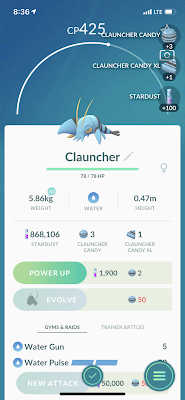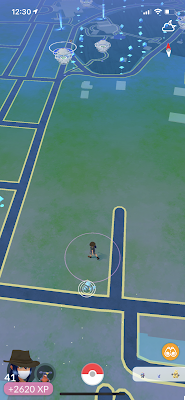My editor on the Better Posters book forwarded the copy of Jon Schwabish’s book Better Data Visualizations. (I have not read it yet, but hope to soon!) If you remember of one the rejected cover designs I posted a while back, it’s fair to say we dodged a bullet by changing my book cover.
Similar titles, concept, colour scheme, and layout? These covers would have had the Pokémon problem.
I play Pokémon Go. I have a dog and it gives me something to do while I walk. When you’re playing, you usually see a screen something like this:
When I saw a screen like the one above, I thought, “Ooh. What’s that?” The game periodically introduces new Pokémon, and one of the newer ones (shown above) is a new snapping shrimp inspired Pokémon called Clauncher.

I study crustaceans, so obviously a lot of the crustacean inspired Pokémon are my favourites.
But what struck me when I was looking for those first few Claunchers was how obvious it was when the first one popped onto my screen that I had never seen it before.
The more I thought about it, the more I realized how brilliant the Pokémon designers are. When you’re playing, you need to clearly distinguish different characters. Those characters are appearing as just a few pixels on the screen.
Even though these are all nominally “cat Pokémon,” it’s easy to recognize them as different kinds of characters.
Conference posters suffer badly from the Pokémon problem.
There is a lot of sameness on those poster boards. I remember someone saying that if you image search for “Good conference poster”...
and then search for “Bad conference poster,” the results look... almost the same.
How do the Pokémon designers do it? Mostly they pay attention to colour and shape. Some Pokémon are light, some are dark, some are striped. They generally don’t have subtle differences (though some of the shiny ones are quite a bit like the normal ones). They colours and patterns are big and bold.
But even if you saw them in grayscale or in outline, each Pokémon cuts a different silhouette.
As a poster maker, you’re probably going to have a rectangular poster. But you can pay a lot of attention to the shapes within your poster. Things that are not rectangular are going to make a strong impression and distinguish your poster from the crowd.
Having a strong colour scheme is even better. You can see the colour of something from a long way away, long before you can see any detail. When I walk through poster sessions, many posters are black text on a white background.
In big sessions, though, there is often someone who has a black poster with white text, and it just pops out.
But that is still monochrome. When I have images, I like to use the eyedropper tool to take something from the image and make it the dominant colour for the poster.
In this example, I sampled the yellow in the glowing ball.
But I could have easily pulled from the dark blues in the background.
Even though all four have the identical content, nobody would mistake one for any of the others if they were hanging up in the poster hall.
This is one of the reasons conference templates create problems for presenters. For a local student conference, I once provided all the student with a template of black text on white background. It’s the most readable, right? It was bad, because it was so monotonous to look at.
So to get back to the cover of my book and Jon’s book... it would have been a disaster for both of us if my cover had
stayed the same. It’s enough that the topics and title are similar, but
if those covers had been so much alike?
I think there would have been a lot of readers who would have confused our books. People would have thought, “Well, I am going to show data, but where’s the stuff on posters?” Or “Man, I’m show slogging through a lot of poster stuff to learn a little about data visualizations.”
And the moral of the story is: Look for ways to make your poster as distinct as a Pokémon!
Related posts
Sunday scraps: Second book cover draft
Sunday scraps: Third book cover draft
External links















No comments:
Post a Comment